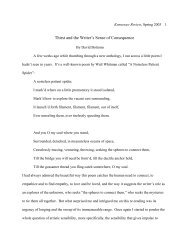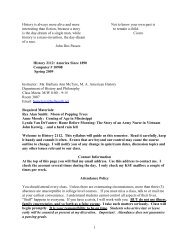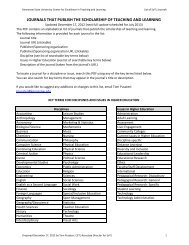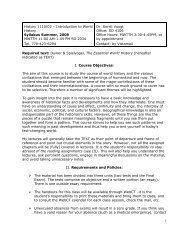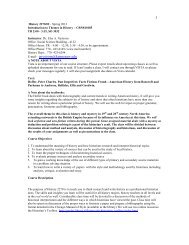Food, Gender and Cultural Hegemony - Kennesaw State University
Food, Gender and Cultural Hegemony - Kennesaw State University
Food, Gender and Cultural Hegemony - Kennesaw State University
Create successful ePaper yourself
Turn your PDF publications into a flip-book with our unique Google optimized e-Paper software.
Cualli 134<br />
191). There is a story that one Spanish priest "of more logic than orthodoxy" reached<br />
the conclusion that the absence of grapes <strong>and</strong> wheat in the New World meant that God<br />
did not intend that the indigenous peoples of America be Christianized (Crosby 71).<br />
The Spanish diet just prior to 1492 consisted of dinner (between 10 <strong>and</strong> 11 AM<br />
in the morning) <strong>and</strong> supper (at 6 or 7 PM.) Dinner was the largest meal. Elites would<br />
expect three courses, not counting soups, side dishes, <strong>and</strong> desserts. Quantity was<br />
emphasized over quality, but wine was a must. Among the popular classes there<br />
might only be one or two courses. Wheat bread <strong>and</strong> meat were the principal foods.<br />
Beef, pork, mutton, goat, <strong>and</strong> poultry <strong>and</strong> wild game were roasted on a spit, boiled or<br />
cut up <strong>and</strong> stewed. Stews were heavily spiced, reflecting the Moorish influence<br />
(Domingo 17-29). Vinegar, salt, cloves, cori<strong>and</strong>er, saffron, pepper, ginger, cinnamon,<br />
pine nuts, onions <strong>and</strong> parsley were frequently used spices. Olive oil was indispensable<br />
for cooking <strong>and</strong> flavor. Eggs <strong>and</strong> fruit (both fresh <strong>and</strong> dried) were accompaniments.<br />
Vegetables were few: onions, carrots, turnips, <strong>and</strong> cabbages were used but not<br />
esteemed. The only beverages were water <strong>and</strong> wine (Oliveira Marques 16-29). Only<br />
the elite had wine everyday, but all Spaniards regarded it as essential (Domingo 26).<br />
Furniture was scanty in the houses of both the popular classes <strong>and</strong> the elite<br />
prior to the sixteenth century. Benches were more common than chairs <strong>and</strong> often<br />
people sat on cushions or carpets to eat. Tables appeared in elite houses in the<br />
medieval period, but were seldom seen in the houses of the popular classes. Often a<br />
table consisted only of a board mounted over trestles, <strong>and</strong> was frequently carried<br />
from room to room. Round pieces of bread were commonly used as plates even in<br />
elite banquets. Silverware apart from spoons was rare before the eighteenth century.<br />
Most people carried their own knives. Often soup was served in large pots that served<br />
as a common bowl. Large goblets were used for wine. There was a custom of<br />
washing h<strong>and</strong>s before <strong>and</strong> after eating since the h<strong>and</strong>s were frequently used for eating<br />
(Oliveira Marques 28-30). In spite of the primitive trappings, the banquets of the elite<br />
were highly ceremonial. For example it was the custom to precede each dish, as well<br />
as the wine, with servants bearing torches under the leadership of an usher:<br />
Recipe for rabbit (16 th Century Treatise on Cooking)<br />
[Type text]



